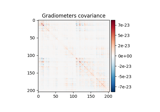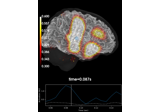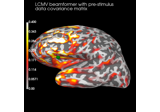mne.beamformer.make_lcmv#
- mne.beamformer.make_lcmv(info, forward, data_cov, reg=0.05, noise_cov=None, label=None, pick_ori=None, rank='info', weight_norm='unit-noise-gain-invariant', reduce_rank=False, depth=None, inversion='matrix', verbose=None)[source]#
Compute LCMV spatial filter.
- Parameters:
- info
mne.Info The
mne.Infoobject with information about the sensors and methods of measurement. Specifies the channels to include. Bad channels (ininfo['bads']) are not used.- forwardinstance of
Forward Forward operator.
- data_covinstance of
Covariance The data covariance.
- reg
float The regularization for the whitened data covariance.
- noise_covinstance of
Covariance The noise covariance. If provided, whitening will be done. Providing a noise covariance is mandatory if you mix sensor types, e.g. gradiometers with magnetometers or EEG with MEG.
- labelinstance of
Label Restricts the LCMV solution to a given label.
- pick_ori
None|str For forward solutions with fixed orientation, None (default) must be used and a scalar beamformer is computed. For free-orientation forward solutions, a vector beamformer is computed and:
NoneOrientations are pooled after computing a vector beamformer (Default).
'normal'Filters are computed for the orientation tangential to the cortical surface.
'max-power'Filters are computed for the orientation that maximizes power.
'vector'Keeps the currents for each direction separate
- rank
None| ‘info’ | ‘full’ |dict This controls the rank computation that can be read from the measurement info or estimated from the data. When a noise covariance is used for whitening, this should reflect the rank of that covariance, otherwise amplification of noise components can occur in whitening (e.g., often during source localization).
NoneThe rank will be estimated from the data after proper scaling of different channel types.
'info'The rank is inferred from
info. If data have been processed with Maxwell filtering, the Maxwell filtering header is used. Otherwise, the channel counts themselves are used. In both cases, the number of projectors is subtracted from the (effective) number of channels in the data. For example, if Maxwell filtering reduces the rank to 68, with two projectors the returned value will be 66.'full'The rank is assumed to be full, i.e. equal to the number of good channels. If a
Covarianceis passed, this can make sense if it has been (possibly improperly) regularized without taking into account the true data rank.dictCalculate the rank only for a subset of channel types, and explicitly specify the rank for the remaining channel types. This can be extremely useful if you already know the rank of (part of) your data, for instance in case you have calculated it earlier.
This parameter must be a dictionary whose keys correspond to channel types in the data (e.g.
'meg','mag','grad','eeg'), and whose values are integers representing the respective ranks. For example,{'mag': 90, 'eeg': 45}will assume a rank of90and45for magnetometer data and EEG data, respectively.The ranks for all channel types present in the data, but not specified in the dictionary will be estimated empirically. That is, if you passed a dataset containing magnetometer, gradiometer, and EEG data together with the dictionary from the previous example, only the gradiometer rank would be determined, while the specified magnetometer and EEG ranks would be taken for granted.
The default is
'info'.- weight_norm
str|None Can be:
NoneThe unit-gain LCMV beamformer [1] will be computed.
'unit-noise-gain'The unit-noise gain minimum variance beamformer will be computed (Borgiotti-Kaplan beamformer) [1], which is not rotation invariant when
pick_ori='vector'. This should be combined withstc.project('pca')to follow the definition in [1].
'nai'The Neural Activity Index [2] will be computed, which simply scales all values from
'unit-noise-gain'by a fixed value.
'unit-noise-gain-invariant'Compute a rotation-invariant normalization using the matrix square root. This differs from
'unit-noise-gain'only whenpick_ori='vector', creating a solution that:Is rotation invariant (
'unit-noise-gain'is not);Satisfies the first requirement from [1] that
w @ w.conj().T == I, whereas'unit-noise-gain'has non-zero off-diagonals; butDoes not satisfy the second requirement that
w @ G.T = θI, which arguably does not make sense for a rotation-invariant solution.
Defaults to
'unit-noise-gain-invariant'.- reduce_rank
bool If True, the rank of the denominator of the beamformer formula (i.e., during pseudo-inversion) will be reduced by one for each spatial location. Setting
reduce_rank=Trueis typically necessary if you use a single sphere model with MEG data.Changed in version 0.20: Support for reducing rank in all modes (previously only supported
pick='max_power'with weight normalization).- depth
None|float|dict How to weight (or normalize) the forward using a depth prior. If float (default 0.8), it acts as the depth weighting exponent (
exp) to use None is equivalent to 0, meaning no depth weighting is performed. It can also be adictcontaining keyword arguments to pass tomne.forward.compute_depth_prior()(see docstring for details and defaults). This is effectively ignored whenmethod='eLORETA'.Changed in version 0.20: Depth bias ignored for
method='eLORETA'.New in version 0.18.
- inversion‘single’ | ‘matrix’
This determines how the beamformer deals with source spaces in “free” orientation. Such source spaces define three orthogonal dipoles at each source point. When
inversion='single', each dipole is considered as an individual source and the corresponding spatial filter is computed for each dipole separately. Wheninversion='matrix', all three dipoles at a source vertex are considered as a group and the spatial filters are computed jointly using a matrix inversion. Whileinversion='single'is more stable,inversion='matrix'is more precise. See section 5 of [3]. Defaults to'matrix'.New in version 0.21.
- verbose
bool|str|int|None Control verbosity of the logging output. If
None, use the default verbosity level. See the logging documentation andmne.verbose()for details. Should only be passed as a keyword argument.
- info
- Returns:
- filtersinstance of
Beamformer Dictionary containing filter weights from LCMV beamformer. Contains the following keys:
- ‘kind’str
The type of beamformer, in this case ‘LCMV’.
- ‘weights’array
The filter weights of the beamformer.
- ‘data_cov’instance of Covariance
The data covariance matrix used to compute the beamformer.
- ‘noise_cov’instance of Covariance | None
The noise covariance matrix used to compute the beamformer.
- ‘whitener’None | ndarray, shape (n_channels, n_channels)
Whitening matrix, provided if whitening was applied to the covariance matrix and leadfield during computation of the beamformer weights.
- ‘weight_norm’str | None
Type of weight normalization used to compute the filter weights.
- ‘pick-ori’None | ‘max-power’ | ‘normal’ | ‘vector’
The orientation in which the beamformer filters were computed.
- ‘ch_names’list of str
Channels used to compute the beamformer.
- ‘proj’array
Projections used to compute the beamformer.
- ‘is_ssp’bool
If True, projections were applied prior to filter computation.
- ‘vertices’list
Vertices for which the filter weights were computed.
- ‘is_free_ori’bool
If True, the filter was computed with free source orientation.
- ‘n_sources’int
Number of source location for which the filter weight were computed.
- ‘src_type’str
Type of source space.
- ‘source_nn’ndarray, shape (n_sources, 3)
For each source location, the surface normal.
- ‘proj’ndarray, shape (n_channels, n_channels)
Projections used to compute the beamformer.
- ‘subject’str
The subject ID.
- ‘rank’int
The rank of the data covariance matrix used to compute the beamformer weights.
- ‘max-power-ori’ndarray, shape (n_sources, 3) | None
When pick_ori=’max-power’, this fields contains the estimated direction of maximum power at each source location.
- ‘inversion’‘single’ | ‘matrix’
Whether the spatial filters were computed for each dipole separately or jointly for all dipoles at each vertex using a matrix inversion.
- filtersinstance of
Notes
The original reference is [2].
To obtain the Sekihara unit-noise-gain vector beamformer, you should use
weight_norm='unit-noise-gain', pick_ori='vector'followed byvec_stc.project('pca', src).Changed in version 0.21: The computations were extensively reworked, and the default for
weight_normwas set to'unit-noise-gain-invariant'.References
Examples using mne.beamformer.make_lcmv#

Compute evoked ERS source power using DICS, LCMV beamformer, and dSPM

